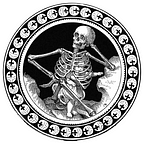Game design stories: Visions of Moria
I have started to design a new game.
I’ve had the initial core concept in my head for some time already, but as part of my game design studies at Aalto University I now have a perfect opportunity to develop the game further, and even use some proper time for it.
At the moment the game’s codename is “Moria”. Of course it won’t be called that in the end, but it’s important to have some name for it. It’s a small thing but it just makes things more structured in your head, or at least in my head.
Starting with a vision
When I decided to finally explore whether the idea of Moria is actually viable, I started my design work by creating a vision document for it. Now, you can find a lot of information about vision documents (aka vision statements, game design document, etc) from the interweb but I suggest reading at least Max Brooke’s blog posts about how he is using vision document while designing he’s new game.
Simply put, vision document is a collaborative (if you are working in a team) and living (constantly changing) document of what you game is about. It doesn’t go into too much detail, but it has the core information about the game’s genre, style and type, production realities, experience goals, etc. After someone has read your vision document, they should have a pretty good understanding of what your game is about.
Visions of Moria
So, what kind of vision I have for Moria? Below are some of the things stated on my vision document:
The concept
Moria is a tabletop rpg / storytelling game about dungeons and treasure, but with a couple of twists.
First, in Moria the heroes have already found the treasure from the bottom of the dungeon, and now they need to get out.
Second, dungeon crawlers are usually about fighting and surviving, but Moria is about the characters, their motivations and pasts: Why do these characters risk their lives for the treasure? Who are they?
Core gameplay
Instead of being a traditional tabletop rpg, Moria taps into the tradition of lightweight modern collaborative storytelling games like Fiasco, Ten Candles and Witch: The Road to Lindisfarne:
- Moria tells very specific kind of stories: escaping from the dungeon
- The stories are not “owned” and designed by a single game master, everyone in the table has an opportunity to participate and tell the story
- Rules are light and they encourage collaborative storytelling
Theme and experience goals
Theme: As a central topic and subject of Moria are the characters and what’s inside of them. The players are encouraged to explore their characters and tell tragic stories about them and their motivations, pasts, hopes and shortcomings.
Experience goals for Moria are:
- There’s a sense of doom and bleakness. It’s very likely that not everyone survives
- Every decision matters, and the decisions are very difficult to make
- The characters become real persons with tragic pasts as the game progresses
- The story has an arc: stakes get higher and higher towards the end of the game
Next: Brainstorming and prototypes
Next step in my design process is to brainstorm mechanics, rules and ideas that will support my vision, theme and experience goals — and then turn those ideas to crude prototypes.
Let’s see how it goes, and how much my vision will change during the design process. Of course there is also always the opportunity that the game idea just isn’t viable after all!
If you want to follow how things progress, follow me on Twitter or on Itch.io.
